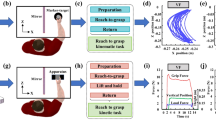Abstract
This study assessed the adaptive response of the reach-to-grasp movement of 12 Parkinson’s disease (PD) and 12 control subjects to a simultaneous perturbation of target object location and size. The main aim was to test further the reported dysfunction of PD subjects in the simultaneous activation of movement components. Participants were required to reach 30 cm to grasp a central illuminated cylinder of either small (0.7 cm) or large (8 cm) diameter. For a small percentage of trials (20/100) a visual perturbation was introduced unexpectedly at the onset of the reaching action. This consisted of a shift of illumination from the central cylinder to a cylinder of differing diameter, which was positioned 20° to the left (n=10) or to the right (n=10). The subject was required to grasp the newly illuminated cylinder. For the Parkinson’s disease subject group, the earliest response to this ’double’ perturbation was in the parameter of peak reaching acceleration, which was on average 50 ms earlier for ’double’ perturbed than for non-perturbed trials. The grasp component response followed more than 500 ms after the earliest transport response. For the control subjects initial signs of a response to the ’double’ perturbation were seen almost simultaneously in the transport parameter of peak arm deceleration, and in the manipulation parameter of maximum grip aperture, but these changes were not evident until more than 400 ms after movement onset. These results indicate that the basal ganglia can be identified as part of a circuit which is involved in the integration of parallel neutral pathways, and which exercise flexibility in the degree to which these components are ’coupled’ functionally. With basal ganglia dysfunction the activation of integration centres that at first gate the flow of information to the parallel channels of reach and grasp seems inefficient.
Similar content being viewed by others
Author information
Authors and Affiliations
Additional information
Received: 29 May 1998 / Accepted: 19 October 1998
Rights and permissions
About this article
Cite this article
Castiello, U., Bennett, K., Bonfiglioli, C. et al. The reach-to-grasp movement in Parkinson’s disease: response to a simultaneous perturbation of object position and object size. Exp Brain Res 125, 453–462 (1999). https://doi.org/10.1007/s002210050703
Issue Date:
DOI: https://doi.org/10.1007/s002210050703




